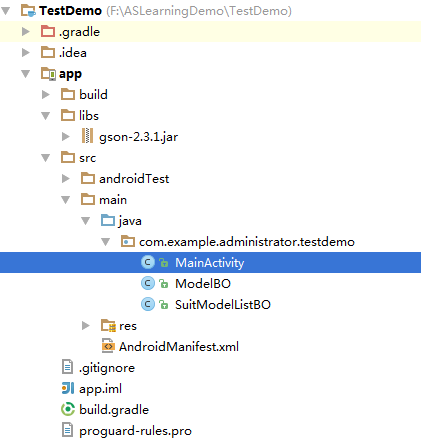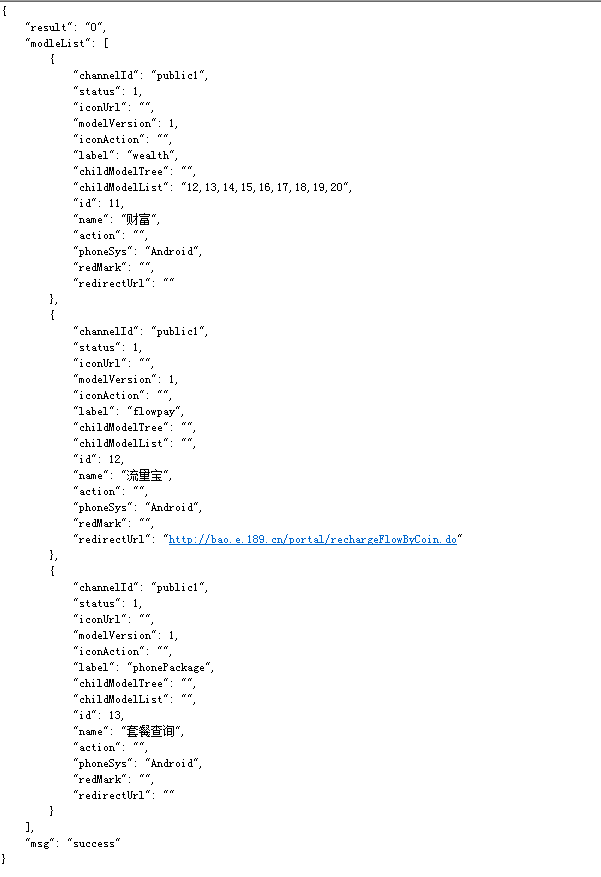一、基础知识简介
1、Gson 是 Google 提供的用来在 Java 对象和 JSON 数据之间进行映射的 Java 类库。可以将一个 JSON 字符串转成一个 Java 对象,或者反过来。
2、JSON(JavaScript Object Notation) 是一种轻量级的数据交换格式。JSON采用完全独立于语言的文本格式,这些特性使JSON成为理想的数据交换语言。易于人阅读和编写,同时也易于机器解析和生成。
21世纪初,Douglas Crockford寻找一种简便的数据交换格式,能够在服务器之间交换数据。当时通用的数据交换语言是XML,但是Douglas Crockford觉得XML的生成和解析都太麻烦,所以他提出了一种简化格式,也就是Json。
Json的规格非常简单,只用一个页面几百个字就能说清楚,而且Douglas Crockford声称这个规格永远不必升级,因为该规定的都规定了。
1) 并列的数据之间用逗号(", ")分隔。
2) 映射用冒号(": ")表示。
3) 并列数据的集合(数组)用方括号("[]")表示。
4) 映射的集合(对象)用大括号("{}")表示。
二、demo项目
2.1 项目结构图

2.2 MainActivity中的代码如下:
package com.example.administrator.testdemo; import android.app.Activity; import android.os.Bundle; import com.google.gson.Gson; import com.google.gson.reflect.TypeToken; import org.json.JSONArray; import org.json.JSONException; import org.json.JSONObject; import java.util.ArrayList; import java.util.List; public class MainActivity extends Activity { private Gson gson = new Gson(); @Override protected void onCreate(Bundle savedInstanceState) { super.onCreate(savedInstanceState); setContentView(R.layout.activity_main); JSONObject jsonObject = generataJSONObjectData(); SuitModelListBO suitModelListBO = gson.fromJson(jsonObject.toString(), new TypeToken<SuitModelListBO>() { }.getType()); //将json类型的数据转化为Bean类型数据 List<ModelBO> modelList = suitModelListBO.modleList; String modelListStr = gson.toJson(modelList); //将Bean类型数据转化为json类型数据 List<ModelBO> ChildModelBoList = gson.fromJson(modelListStr, new TypeToken<ArrayList<ModelBO>>() { }.getType()); //将json类型的数据转化为Bean类型数据 } /*生成JSONObject类型的数据
*/
private JSONObject generataJSONObjectData() { JSONObject jsonObject = new JSONObject(); try { JSONObject jsonObject1 = new JSONObject(); jsonObject1.put("status", 1); jsonObject1.put("channelId", "public1"); jsonObject1.put("iconUrl", ""); jsonObject1.put("modelVersion", 1); jsonObject1.put("iconAction", ""); jsonObject1.put("label", "wealth"); jsonObject1.put("childModelTree", ""); jsonObject1.put("id", 11); jsonObject1.put("childModelList", "12,13,14,15,16,17,18,19,20"); jsonObject1.put("name", "财富"); jsonObject1.put("phoneSys", "Android"); jsonObject1.put("action", ""); jsonObject1.put("redMark", ""); jsonObject1.put("redirectUrl", ""); JSONObject jsonObject2 = new JSONObject(); jsonObject2.put("status", 1); jsonObject2.put("channelId", "public1"); jsonObject2.put("iconUrl", ""); jsonObject2.put("modelVersion", 1); jsonObject2.put("iconAction", ""); jsonObject2.put("label", "flowpay"); jsonObject2.put("childModelTree", ""); jsonObject2.put("id", 12); jsonObject2.put("childModelList", ""); jsonObject2.put("name", "流量宝"); jsonObject2.put("phoneSys", "Android"); jsonObject2.put("action", ""); jsonObject2.put("redMark", ""); jsonObject2.put("redirectUrl", "http://bao.e.189.cn/portal/rechargeFlowByCoin.do"); JSONObject jsonObject3 = new JSONObject(); jsonObject3.put("status", 1); jsonObject3.put("channelId", "public1"); jsonObject3.put("iconUrl", ""); jsonObject3.put("modelVersion", 1); jsonObject3.put("iconAction", ""); jsonObject3.put("label", "phonePackage"); jsonObject3.put("childModelTree", ""); jsonObject3.put("id", 13); jsonObject3.put("childModelList", ""); jsonObject3.put("name", "套餐查询"); jsonObject3.put("phoneSys", "Android"); jsonObject3.put("action", ""); jsonObject3.put("redMark", ""); jsonObject3.put("redirectUrl", ""); JSONArray modleList = new JSONArray(); modleList.put(jsonObject1); modleList.put(jsonObject2); modleList.put(jsonObject3); jsonObject.put("msg", "success"); jsonObject.put("modleList", modleList); jsonObject.put("result", "0"); } catch (JSONException e) { e.printStackTrace(); } return jsonObject; } }
2.3 ModelBO中的代码如下:
package com.example.administrator.testdemo; public class ModelBO { public long id; public String channelId; public String name; public String iconUrl; public String phoneSys; public long modelVersion; public String action; public String redMark; public String iconAction; public String label; public String redirectUrl; public long status; public String childModelTree; public String childModelList; public ModelBO() { } public ModelBO(long id, String channelId, String name, String iconUrl, String phoneSys, long modelVersion, String action, String redMark, String iconAction, String label, String redirectUrl, long status, String childModelTree, String childModelList) { this.id = id; this.channelId = channelId; this.name = name; this.iconUrl = iconUrl; this.phoneSys = phoneSys; this.modelVersion = modelVersion; this.action = action; this.redMark = redMark; this.iconAction = iconAction; this.label = label; this.redirectUrl = redirectUrl; this.status = status; this.childModelTree = childModelTree; this.childModelList = childModelList; } }
2.4 SuitModelListBO中的代码如下:
package com.example.administrator.testdemo; import java.util.List; public class SuitModelListBO { public List<ModelBO> modleList; public Long timeStamp; public int result; public String msg; }
三、工具类
项目中如果多次使用GSON解析数据的时候,避免多次创建Gson对象,可以创建一个工具类实现JSONObject转化为实体类或实体类转化为JSONObject
import java.util.ArrayList; import java.util.List; import com.google.gson.Gson; import com.google.gson.JsonSyntaxException; import com.google.gson.reflect.TypeToken; public class DataParser { // 使用Gson将jsonString转化为javaBean object public static <T> T stringToModelObject(String jsonString, Class<T> cls) { try { T t = null; Gson gson = new Gson(); t = gson.fromJson(jsonString, cls); return t; } catch (JsonSyntaxException e) { // TODO Auto-generated catch block e.printStackTrace(); return null; } } // 使用Gson进行解析 List<Object> public static <T> List<T> getGsonArray(String jsonString, Class<T> cls) { try { List<T> list = new ArrayList<T>(); Gson gson = new Gson(); list = gson.fromJson(jsonString, new TypeToken<List<T>>() { }.getType()); return list; } catch (JsonSyntaxException e) { // TODO Auto-generated catch block e.printStackTrace(); return null; } } }
3.1 此工具方法使用例子
3.1.1 一个接口的返回GSONObject结果如下所示:
返回结果 { "items": [ { "beginDate": "20140101000000", "endDate": "20140131000000", "items": [ { "balanceAmount": "12", "beginTime": "Wed Jan 01 00:00:00 GMT+08:00 2014", "endTime": "Fri Jan 31 00:00:00 GMT+08:00 2014", "ownerID": null, "ownerType": "80A", "ratableAmount": "12", "ratableResourceID": "500246906", "ratableResourcename": "后付费乐享3G主副卡上网版国内点对点彩信条数", "unitTypeId": "2" }, { "balanceAmount": "55", "beginTime": "Wed Jan 01 00:00:00 GMT+08:00 2014", "endTime": "Fri Jan 31 00:00:00 GMT+08:00 2014", "ownerID": null, "ownerType": "80A", "ratableAmount": "60", "ratableResourceID": "500246905", "ratableResourcename": "后付费乐享3G主副卡上网版国内点对点短信条数", "unitTypeId": "2" } ], "productOFFName": "后付费乐享3G主副卡上网版_2011年9月" } ], "paraFieldResult": null, "serviceResultCode": "0", "totalBalanceAvailable": null, "result": "0" } 错误返回结果 Json示例: Content-type: text/html; charset=utf-8 { “result”:- 101, “msg”:”发生未知错误” }
3.2 此接口对应的实体QueryCTPackageResponseBo的定义如下所示:
public class QueryCTPackageResponseBo { public int result;//0 表示查询成功,其他表示查询失败,参考错误码对应表 public String paraFieldResult;//错误信息 public int serviceResultCode; //业务结果码,和result一致 public int totalBalanceAvailable;//实时可用总余额 public String msg; public List<PackageList> items; }
PackageList的定义如下所示:
public class PackageList { public List<PackageBean> items; public String beginDate; public String endDate; public String productOFFName; }
PackageBean的定义如下所示:
package cn.com.chinatelecom.account.bean; import java.io.Serializable; public class PackageBean implements Serializable{ public int balanceAmount; public String beginTime; public String endTime; public long ownerID; public String ownerType; public int ratableAmount; public long ratableResourceID; public String ratableResourcename; public int unitTypeId; public String nameType; }
3.3 将从服务器端返回的GSONObject转化为对应的实体:
QueryCTPackageResponseBo queryCTPackageResponseBo = DataParser .stringToModelObject(response.toString(), QueryCTPackageResponseBo.class);
四、如果此博客的内容无法满足需要,那么值得参考的博客网址 http://blog.csdn.net/lk_blog/article/details/7685169
